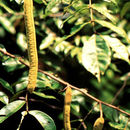en
names in breadcrumbs


Inga thibaudiana (lat. Inga thibaudiana) - paxlakimilər fəsiləsinin inqa cinsinə aid bitki növü.
Inga thibaudiana (lat. Inga thibaudiana) - paxlakimilər fəsiləsinin inqa cinsinə aid bitki növü.
Inga thibaudiana ist eine Baumart aus der Unterfamilie der Mimosengewächse (Mimosoideae). Sie ist in Mittel- und Südamerika beheimatet.
Inga thibaudiana ist ein bis zu 25 Meter hoher Baum mit grün-, grau- und rötlich-braun gefleckter Rinde und dunkelbraunen, flaumig rostrot behaarten Zweigen. Die oberseitig kahlen und unterseitig dicht feinflaumig behaarten Blätter sind in der Regel fünf- bis sechsfach paarig gefiedert, die Blättchen verkehrt lanzettlich bis elliptisch. Das äußerste Blättchenpaar ist 7,4 bis 17,5 Zentimeter lang und 2,8 bis 7,6 Zentimeter breit, das innerste 3 bis 10,2 Zentimeter lang und 1,5 bis 4,9 Zentimeter breit.
Der Blattstiel ist ebenso wie die 7 bis 20 Zentimeter lange Blattrhachis geflügelt oder zylindrisch, zwischen jedem Blattpaar sitzen becherförmige, grüne bis orange oder schwarze Drüsen. Die Nebenblätter sind 1 bis 3 Millimeter lang, behaart und hinfällig.
Die Blütenstände sind achselbürtige, dichte Ähren, die in Gruppen zu zwei bis fünf Stück stehen. Der Schaft ist 1 bis 4 Zentimeter lang und flaumig rostrot behaart, die Rhachis 1 bis 3,5 Zentimeter lang. Die Blüten sind gelblich-grün, die Staubblätter weiß. Die flachen, geraden oder gebogenen Früchte sind 8 bis 30 Zentimeter lang und 1,8 bis 2,5 Zentimeter breit.
Inga thibaudiana ist heimisch von Mexiko bis Bolivien und Zentral-Brasilien.
Die Art wurde 1825 von Augustin-Pyrame de Candolle erstbeschrieben.
Inga thibaudiana ist eine Baumart aus der Unterfamilie der Mimosengewächse (Mimosoideae). Sie ist in Mittel- und Südamerika beheimatet.
Inga thibaudiana is a species of tropical tree in the family Fabaceae. It occurs in Central and South America, where it is known as guaba de mono, guabito [2] and guavo de playa.[1]
Inga thibaudiana is a small tree with a densely branched crown growing to a height of about 20 metres (66 ft). The leaves are pinnate with four to seven pairs of elliptical or oblanceolate leaflets, each with an elongated, often curved tip, and a bristle-like spike at the apex. There is a small pot-shaped gland at the base of each pair of leaflets. The underside of the leaves are densely felted with short brown hairs and the twigs are also hairy. The white flowers have a wispy appearance and are in short spikes with hairy stalks. Each has a short calyx, a tubular corolla, projecting stamens and a long style. The fruits are long, flattened seed pods containing many seeds.[3] Inga thibaudiana could be confused with Inga multijuga, but that species does not have leaflets with elongated tips nor a network of secondary veins along the edges of the leaflets.[3]
Inga thibaudiana occurs in Central and South America, the Caribbean region, and Trinidad and Tobago. Its range extends from south-east Mexico to Peru, Bolivia and Brazil.[1] It is found in primary and secondary woodland, in disturbed ground, on road verges and field edges at altitudes of up to 700 metres (2,300 ft) in regions with high rainfall and a humid climate.[3]
Inga thibaudiana flowers and fruits throughout the year. It is a fast-growing tree and makes good firewood.[3] It grows in areas of forest that are seasonally flooded and is often associated with other trees, such as Virola duckei and Brownea grandiceps. Many lianas and epiphytic plants grow among its branches.[4]
Inga thibaudiana is a species of tropical tree in the family Fabaceae. It occurs in Central and South America, where it is known as guaba de mono, guabito and guavo de playa.
Inga thibaudiana là một loài thực vật có hoa trong họ Đậu. Loài này được DC. miêu tả khoa học đầu tiên.[2]
Inga thibaudiana là một loài thực vật có hoa trong họ Đậu. Loài này được DC. miêu tả khoa học đầu tiên.